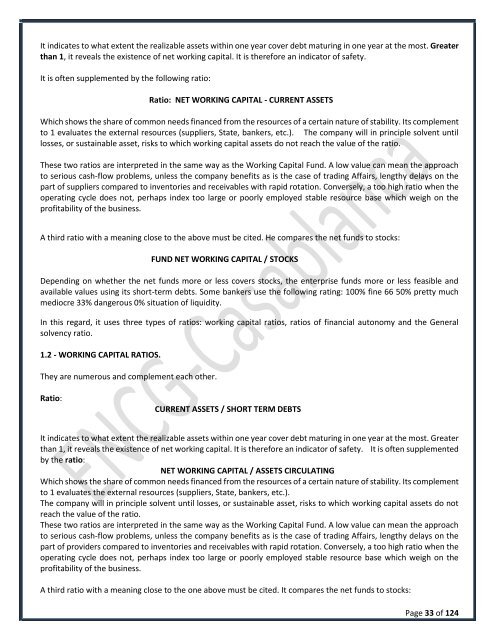Optimization of the company's cash flow
This book is about the company's treasuries and financial management, more specifically; it shows how a company can manage its treasury in an efficient and short way.
This book is about the company's treasuries and financial management, more specifically; it shows how a company can manage its treasury in an efficient and short way.
You also want an ePaper? Increase the reach of your titles
YUMPU automatically turns print PDFs into web optimized ePapers that Google loves.
It indicates to what extent <strong>the</strong> realizable assets within one year cover debt maturing in one year at <strong>the</strong> most. Greater<br />
than 1, it reveals <strong>the</strong> existence <strong>of</strong> net working capital. It is <strong>the</strong>refore an indicator <strong>of</strong> safety.<br />
It is <strong>of</strong>ten supplemented by <strong>the</strong> following ratio:<br />
Ratio: NET WORKING CAPITAL - CURRENT ASSETS<br />
Which shows <strong>the</strong> share <strong>of</strong> common needs financed from <strong>the</strong> resources <strong>of</strong> a certain nature <strong>of</strong> stability. Its complement<br />
to 1 evaluates <strong>the</strong> external resources (suppliers, State, bankers, etc.). The company will in principle solvent until<br />
losses, or sustainable asset, risks to which working capital assets do not reach <strong>the</strong> value <strong>of</strong> <strong>the</strong> ratio.<br />
These two ratios are interpreted in <strong>the</strong> same way as <strong>the</strong> Working Capital Fund. A low value can mean <strong>the</strong> approach<br />
to serious <strong>cash</strong>-<strong>flow</strong> problems, unless <strong>the</strong> company benefits as is <strong>the</strong> case <strong>of</strong> trading Affairs, lengthy delays on <strong>the</strong><br />
part <strong>of</strong> suppliers compared to inventories and receivables with rapid rotation. Conversely, a too high ratio when <strong>the</strong><br />
operating cycle does not, perhaps index too large or poorly employed stable resource base which weigh on <strong>the</strong><br />
pr<strong>of</strong>itability <strong>of</strong> <strong>the</strong> business.<br />
A third ratio with a meaning close to <strong>the</strong> above must be cited. He compares <strong>the</strong> net funds to stocks:<br />
FUND NET WORKING CAPITAL / STOCKS<br />
Depending on whe<strong>the</strong>r <strong>the</strong> net funds more or less covers stocks, <strong>the</strong> enterprise funds more or less feasible and<br />
available values using its short-term debts. Some bankers use <strong>the</strong> following rating: 100% fine 66 50% pretty much<br />
mediocre 33% dangerous 0% situation <strong>of</strong> liquidity.<br />
In this regard, it uses three types <strong>of</strong> ratios: working capital ratios, ratios <strong>of</strong> financial autonomy and <strong>the</strong> General<br />
solvency ratio.<br />
1.2 - WORKING CAPITAL RATIOS.<br />
They are numerous and complement each o<strong>the</strong>r.<br />
Ratio:<br />
CURRENT ASSETS / SHORT TERM DEBTS<br />
It indicates to what extent <strong>the</strong> realizable assets within one year cover debt maturing in one year at <strong>the</strong> most. Greater<br />
than 1, it reveals <strong>the</strong> existence <strong>of</strong> net working capital. It is <strong>the</strong>refore an indicator <strong>of</strong> safety. It is <strong>of</strong>ten supplemented<br />
by <strong>the</strong> ratio:<br />
NET WORKING CAPITAL / ASSETS CIRCULATING<br />
Which shows <strong>the</strong> share <strong>of</strong> common needs financed from <strong>the</strong> resources <strong>of</strong> a certain nature <strong>of</strong> stability. Its complement<br />
to 1 evaluates <strong>the</strong> external resources (suppliers, State, bankers, etc.).<br />
The company will in principle solvent until losses, or sustainable asset, risks to which working capital assets do not<br />
reach <strong>the</strong> value <strong>of</strong> <strong>the</strong> ratio.<br />
These two ratios are interpreted in <strong>the</strong> same way as <strong>the</strong> Working Capital Fund. A low value can mean <strong>the</strong> approach<br />
to serious <strong>cash</strong>-<strong>flow</strong> problems, unless <strong>the</strong> company benefits as is <strong>the</strong> case <strong>of</strong> trading Affairs, lengthy delays on <strong>the</strong><br />
part <strong>of</strong> providers compared to inventories and receivables with rapid rotation. Conversely, a too high ratio when <strong>the</strong><br />
operating cycle does not, perhaps index too large or poorly employed stable resource base which weigh on <strong>the</strong><br />
pr<strong>of</strong>itability <strong>of</strong> <strong>the</strong> business.<br />
A third ratio with a meaning close to <strong>the</strong> one above must be cited. It compares <strong>the</strong> net funds to stocks:<br />
Page 33 <strong>of</strong> 124


